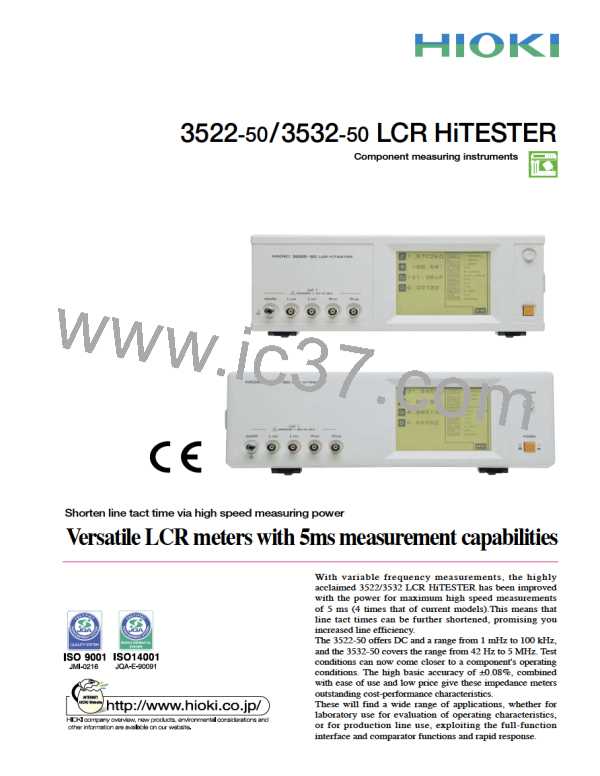6
Measurement accuracy and ranges *
Conditions : temperature range 23 °C ±5 °C (73 °F ±9 °F), 80% rh or less (no condensation)
After a 60-minute warm-up period, and open-circuit and short-circuit corrections are made.
Using the 9262 TEST FIXTURE, and measurement signal levels 1 V to 5 V (3522-50), 0.501 V to 1.000 V (3532-50); measurement speed SLOW2.
* Measurement ranges and accuracy depend on the test fixture used, the measurement signal levels, and the measurement speed.
3522-50 Accuracy
Range Impedance
DC
1m to 99.99Hz 100.0 to 999.9Hz 1.000 to 10.00kHz 10.01 to 100.0kHz
Upper figure A .. basic accuracy for |Z| (± % rdg.)
B is coefficient for sample impedance
200MΩ
100MΩ
A=7 B=5
A=4 B=3
A=4.5 B=1
A=4.5 B=1
A=1 B=1
10MΩ
A=3 B=1.5 A=2.5 B=1.5
Lower figure A .. basic accuracy for θ (± deg.)
10MΩ
10MΩ
A=2 B=0.5 A=0.7 B=0.4 A=0.7 B=0.4 A=1.5 B=0.5
B is coefficient for sample impedance
A=0.5 B=0.3
A=0.2 B=0.05
1MΩ
A=1 B=0.2 A=0.7 B=0.2 A=0.5 B=0.2 A=2
B=0.3
1MΩ
A=0.7 B=0.03 A=0.25 B=0.03 A=0.2 B=0.03 A=0.7 B=0.03
When DC resistance measurement,
A is accuracy for R (± % rdg.)
1MΩ
100kΩ
A=0.35 B=0.02 A=0.15 B=0.02 A=0.1 B=0.02 A=0.5 B=0.1
A=0.4 B=0.01 A=0.2 B=0.002 A=0.15 B=0.002 A=0.35 B=0.01
B is coefficient for sample resistance
100kΩ
100kΩ
10kΩ
A=0.28 B=0.002 A=0.12 B=0.002 A=0.08 B=0.002 A=0.1 B=0.02
A=0.38 B=0.002 A=0.15 B=0.002 A=0.1 B=0.002 A=0.2 B=0.002
A=0.25 B=0.001 A=0.1 B=0.001 A=0.05 B=0.001 A=0.08 B=0.002
A=0.36 B=0.001 A=0.12 B=0.001 A=0.08 B=0.001 A=0.15 B=0.001
A=0.25 B=0.001 A=0.1 B=0.001 A=0.05 B=0.001 A=0.08 B=0.002
A=0.36 B=0.01 A=0.15 B=0.01 A=0.15 B=0.01 A=0.15 B=0.02
A=0.25 B=0.005 A=0.1 B=0.005 A=0.05 B=0.005 A=0.08 B=0.01
The expression for calculating accuracy is
different in the ranges above 1 kΩ and below
100 Ω.
10kΩ
10kΩ
A=0.1 B=0.01
1kΩ
For details refer to the following expressions.
1kΩ
1kΩ
100Ω
Range 1 kΩ and above...
100Ω
100Ω
B × | 10 × Zx - range |
A=0.1 B=0.02
A=0.2 B=0.05
A=0.3 B=0.3
A=1 B=0.5
Accuracy = A +
10Ω
Range
10Ω
A=0.5 B=0.04 A=0.25 B=0.02 A=0.25 B=0.01 A=0.35 B=0.02
A=0.35 B=0.02 A=0.2 B=0.01 A=0.15 B=0.01 A=0.2 B=0.02
Range 100 Ω and below...
10Ω
1Ω
B × | range - Zx | × 10
Accuracy = A +
Range
1Ω
1Ω
A=1 B=0.6
A=0.6 B=0.4
A=0.5 B=0.3 A=0.35 B=0.2 A=0.7 B=0.3
A=0.35B=0.2 A=0.3 B=0.1 A=0.45 B=0.1
100mΩ
Zx is the measured impedance
of the sample (|Z|).
100mΩ
100mΩ
A=7 B=4
A=5 B=2
A=3.5 B=1.5 A=2.5 B=1.5 A=3.5 B=1.5
10mΩ
A=2.5 B=1
A=1.5 B=1
A=2
B=1
3532-50 Accuracy
Range Impedance
42 to 99.99 Hz
100.0 Hz to 1.000 kHz 1.001 to 10.00 kHz
10.01 to 100.0 kHz 100.1 k to 1.000 MHz
1.001 to 5 MHz
200 MΩ A=4
B=4
A=2
B=2
100 MΩ
10 MΩ
A=2.5
A=0.8
B=2
B=0.4
A=1
A=0.4
B=1.5
B=0.2
10 MΩ
A=1
A=1
B=0.5
B=0.5
10 MΩ
1 MΩ
A=1
B=0.2
B=0.05
B=0.1
A=0.25 B=0.1
A=0.15 B=0.05
A=0.15 B=0.02
1 MΩ
1 MΩ
A=0.4
A=0.3 B=0.08
A=0.3 B=0.08
A=0.25 B=0.04
A=0.15 B=0.02
A=3
A=3
B=1
100 kΩ A=0.3
B=0.5
100 kΩ
10 kΩ
10 kΩ
1 kΩ
A=0.08 B=0.01 A=0.15 B=0.01
A=0.05 B=0.01 A=0.08 B=0.01
A=0.4 B=0.3
A=0.3 B=0.3
* A=2
A=2
B=0.5
B=0.3
A=0.35 B=0.01
A=0.25 B=0.01
100 kΩ
10 kΩ
1 kΩ
A=0.35 B=0.01
A=0.25 B=0.005
A=0.08 B=0.01
A=0.05 B=0.005
A=0.2 B=0.02
A=0.08 B=0.02
A=0.3 B=0.03 * A=1.5 B=0.2
A=0.15 B=0.02 A=1 B=0.2
1 kΩ
100 Ω
100 Ω
10 Ω
10 Ω
1 Ω
A=0.35 B=0.02
A=0.25 B=0.01
A=0.08 B=0.02
A=0.05 B=0.01
A=0.2 B=0.02
A=0.08 B=0.02
A=0.2 B=0.03
A=0.15 B=0.02
A=0.3 B=0.03 * A=1.5 B=0.2
100 Ω
10 Ω
1Ω
A=0.15 B=0.02
A=0.4 B=0.1
A=0.3 B=0.05
A=1
* A=2
A=2
B=0.2
B=1
A=0.4
A=0.3
A=0.7
B=0.04
B=0.1
B=0.4
B=0.2
B=4
A=0.2
A=0.1
B=0.03
B=0.02
A=0.4
B=0.5
1 Ω
B=0.3
A=1
B=1
100 mΩ A=1
100 mΩ A=4
A=0.25 B=0.2
A=0.7 B=0.5
*1.001 MHz and above
(f [MHz]+3)
accuracy ×
A=3
A=2
B=2
B=1
4
100 mΩ
10 mΩ
A=2.5
B=2
■ Method of determining accuracy
• The measurement accuracy can be calculated from the impedance of the
●Example calculation (The value A and B for the 3522-50)
Sample impedance Zx: 500 Ω (measured)
sample, the measurement range, the measurement frequency, and the basic
accuracy A and coefficient B from the above tables.
Measurement conditions: frequency 10 kHz, signal level 2 V, range 1 kΩ
From table above, basic Z accuracy A = 0.08, coefficient B = 0.001.
Inserting these in the calculation expression yields:
• The expression for calculating accuracy is different in the ranges above 1 kΩ
and below 100 Ω.
2
3
• For C and L, find the basic accuracy A and coefficient B either by direct
measurement of the impedance or by approximate calculation as follows.
0.001× | 10 × 5 × 10 −10 |
Z accuracy = 0.08 +
=0.084 (±%rdg.)
3
10
Similarly for θ basic accuracy A = 0.05, coefficient B = 0.001, and thus:
| Zx (Ω) | ≅ ωL (H) (θ ≅ 90˚)
2
3
1
0.001× | 10 × 5 × 10 −10 |
θ accuracy = 0.05 +
=0.054 (±%rdg.)
≅
(θ ≅ - 90˚)
3
ωC (F)
10
≅ R (Ω) (θ ≅ 0˚)

 ASM-SENSOR [ ASM GMBH ]
ASM-SENSOR [ ASM GMBH ]